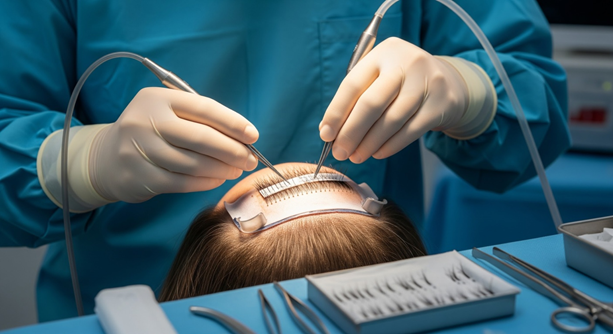You’ve done your research. You’re ready to take control of your hairline. But as excited as you might be about getting a hair transplant, there’s still that one thought in your head: What if something goes wrong? Like any medical procedure, side effects can happen. The good news is that most of them don’t last long. Even better? You can manage many of them with a bit of care.
So before you go in for the treatment, let’s talk about what you may feel after it and how to handle each step with confidence.
Swelling After Surgery? It’s Normal and Manageable
If your forehead or eyes look puffy the next day, don’t be alarmed. Swelling happens to many people right after the procedure. It’s your body’s natural way of reacting and healing. Usually, it clears up in a few days.
To bring the swelling down, sleep with your head raised. Use a cold compress gently. Skip heavy workouts for now. And take the medication your doctor gave you. It’s there to help you heal faster and feel better.
Scabs Will Form—Let Them Fall Off on Their Own
You’ll likely see small scabs where the hair was placed. They might feel dry or tight. Please don’t pick at them, even if they start to itch. Each one protects a new graft. If you remove it too early, you risk damaging that graft.
Instead, wash your hair gently as advised. Use a mild shampoo, apply light pressure, and rinse well. These scabs will come off in about a week or so. Patience now leads to better results later.
Redness and Soreness Are Part of the Process
Feeling sore around your scalp? That’s to be expected. Redness might last for a few days, especially where the hair was taken or placed. Your skin is adjusting and healing.
If pain or redness gets worse instead of better, speak to your clinic. That could be a sign something else is going on. It’s always better to check than to wait and wonder.
That Itch Means You’re Healing—Don’t Scratch
A few days after surgery, your scalp might start to itch. That’s a sign your skin is repairing itself. It’s tempting to scratch, but please don’t. You could pull out a graft or delay healing.
Use a light spray if your clinic gave you one. Ask about moisturisers that won’t harm the area. And try patting, not rubbing, when you feel discomfort. The itch will pass.
Shock Loss Might Scare You, But It’s Only Temporary
You might notice more hair falling out a week or two after your procedure. This phase, called shock loss, catches many off guard. But it’s not a sign of failure. It’s just how your body responds to the change.
Even the transplanted hair can shed before new strands grow in. This is expected. Hair growth comes in cycles. In a few months, you’ll begin to see the difference. If you’re still comparing hair loss treatment options, know that this is part of the long-term gain.
Infection Risks Stay Low With Clean Habits
Infection is rare, but it can happen. Signs might include heat, discharge, or strong pain that doesn’t go away. That’s why keeping your scalp clean is so important in the early days.
Wash your hands before touching your head. Sleep on clean pillows. Avoid crowded places where sweat or dirt could build up. And follow every step of your clinic’s aftercare guide. These habits protect your healing grafts, especially when you’re going through a minimally invasive hair surgery like FUE.
Small Bumps After Surgery? That’s Folliculitis
Sometimes, little bumps appear around the hair follicles. They can look like tiny pimples but are not acne. It’s called folliculitis, and it’s your skin’s reaction to the new growth.
Your clinic may recommend a cream or lotion to clear it up. Don’t press or pop the bumps. Let them heal on their own with the right treatment. Most people see them disappear in just a few days.
Scarring Worries? Ask the Right Questions First
If you’ve had raised scars in the past, be honest with your clinic. Some people are more likely to scar. But that doesn’t mean you can’t have a good outcome. You may just need a different approach.
Techniques like FUE hair restoration Singapore don’t leave the long scar that older methods used to. Bring it up during your consultation and let your surgeon guide you to the best fit for your skin type.
Aftercare Makes All the Difference
Don’t underestimate the small stuff. How you care for your scalp in the first few weeks shapes how well it heals. Your clinic gave you a guide for a reason. Follow it closely.
Wash when told. Rest more. Avoid anything that causes sweat or irritation. This includes alcohol, direct sunlight, and intense workouts. A clean, quiet environment is the best gift you can give your scalp right now.
The reward? hair grafting procedure that feels just like your own.
The Waiting Game Is Worth It
You might not see results right away. That’s normal. New hair takes time to grow. The first few weeks can feel slow or frustrating. Stay calm. The process is working under the surface.
Most people see signs of new growth around month three. Full results show between nine and twelve months. It’s not fast, but it is real progress.
Final Word: You’ve Got This
Hair transplant side effects are part of the healing story, not a reason to worry. With the right care, you’ll get through each stage stronger than before.
You chose this to feel better in your skin. You took a step toward feeling confident again. And even if the process has its ups and downs, you’re moving forward. Stay the course. You’re already on your way.

